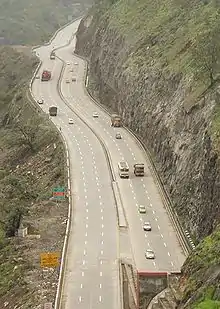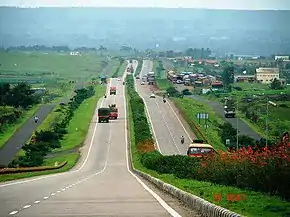Transport in Maharashtra
Maharashtra is a state in the western region of India. It is the second most populous state and third largest state by area in India. Maharashtra is bordered by the Arabian Sea to the west, Gujarat and the Union territory of Dadra and Nagar Haveli to the northwest, Madhya Pradesh to the north and northeast, Chhattisgarh to the east, Karnataka to the south, Telangana to the southeast and Goa to the southwest. The state covers an area of 307,731 km2 (118,816 sq mi) or 9.84% of the total geographical area of India.
Mumbai, the capital city of the state, is India's largest city and the financial capital of the nation. Maharashtra consist three mode of transportation viz. Roads, Railways and Civil aviation. Besides, Maharashtra has three major ports at Mumbai (operated by the Mumbai Port Trust), the JNPT lying across the Mumbai harbour in Navi Mumbai, and in Ratnagiri.
Human powered
.jpg.webp)
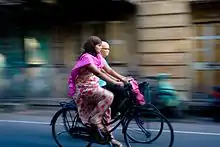
Walking has constituted a major form of transport in ancient times.This mode of transport has always been a first foot for humans. People even used to cover long distances on foot.In rural areas of Maharashtra even now that is a common mode of transport. In many cities in the state like Mumbai or Pune, to make it safer and efficient for pedestrians, a number of skywalks have been proposed or are under construction.For example, the Mumbai Metropolitan Region Development Authority, has commenced the construction of more than 50 skywalks,[1][2]
Bicycles or cycles, have high ownership in the state. the state level. Along with walking, cycling accounts for significant number of the commuter trips for those in the informal sector in both rural and urban areas.From many decades, Pune was known as the cycle city of India. However, the cycle was replaced by motorized two-wheelers from the 1970s onwards. Today, government development authorities are encouraging the setup and use of separate bicycle lanes alongside the roads to combat pollution and ease traffic congestion.
Animal powered
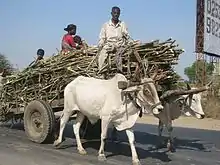
Historically, bullock carts have been the most common mode of transport for goods and to a lesser extent for people in Maharashtra.Bullock carts are still used in rural areas for transporting goods from home to the farm or produce such as sugarcane to the sugar mill.[3] The khilari has been the most popular breed for draft oxen.[4]
Historically, other animals used in the region for transport have been horses (riding and draft), donkeys and elephants.The Bhimthadi horse was a popular indigenous riding horse breed during the Maratha empire era.[5][6] During the British colonial era the horse drawn Tanga and Victoria were popular modes of transport in urban areas.From the 1960s onward, they were gradually replaced by the motorized three-wheeler Autorickshaw, for intermediate public transport.Donkeys are still used on building sites for carrying sand but, unlike the middle-east, they have not been used for riding.
Road Transport
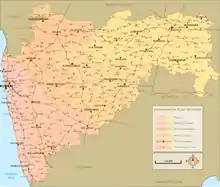
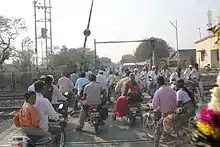
Maharashtra has the largest road network in India at 267,452 kilometres.[7] 17 National Highways connect Maharashtra to six neighbouring states.[8] The length of National Highways in Maharashtra is 4688 kilometres.[9] Maharashtra has a large state highway network. 99.5 per cent of the villages in the state were connected by all-weather roads as of March 2018. The Yeshwantrao Chavan Mumbai-Pune Expressway, the first access controlled toll road project in India was made fully operational in April 2002.
The Maharashtra State Road Transport Corporation (MSRTC) has been providing passenger road transport service in the public sector since 1948, linking most of the towns and villages in and around the state with a large network of operation. These buses, popularly called ST (State Transport), are the preferred mode of transport for much of the populace. In addition to the government run buses, privately run luxury buses also ply between major towns. Other modes of public transport, such as a seven-seater tempo have gained popularity in semi-urban areas.
Rail transport
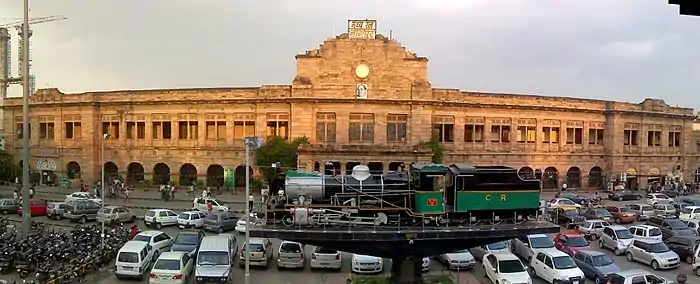
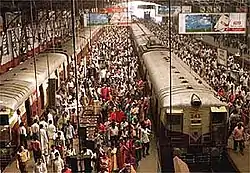
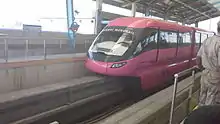
In India, rail transport is mainly provided by Indian Railways under the supervision of the Ministry of Railways. IR is divided into eighteen zones.[10] The IR are further sub-divided into sixty seven divisions, each having a divisional headquarters.[11][12]
Maharashtra is well-connected to other parts of the country with a railway network spanning 5,983 km. Many zonal, and divisional headquarters of Indian railways are based in different cities of the state.
- The Central Railway and the Western Railway zones of the Indian Railways that are headquartered in Mumbai, at Chhatrapati Shivaji Terminus and Churchgate respectively,
- The Nagpur Junction has the division, Nagpur (Central) & Nagpur (South East Central) of Central Railway & South East Central Railway respectively.
- The Nanded division of the South Central Railway that caters to the Marathwada region of Maharashtra and
- The Konkan Railway, a subsidiary of the Indian Railways based in CBD Belapur, Navi Mumbai that serves the Konkan coastal region of Maharashtra and continues down the west coast of India.
Maharashtra also has suburban railway networks in Mumbai and Pune that carry around 6.4 million passengers every day.[13]
In addition to this, Maharashtra also has metro rail and mono rail networks. Currently Mumbai Metro is operational while metro at Nagpur, Navi Mumbai, Nashik and Pune are under construction. Nashik metro is proposed by NMC and Greater Nashik Metro project is implemented by Maharashtra Metro Rail Corporation Limited to connect city with the suburban areas like Nashik Road, Nashik Airport (ozar) and sinnar. Mumbai Monorail is set to become the fifth-largest monorail system in the world, also Navi Mumbai Monorail, Pune Monorail and Nagpur Monorail are proposed.
Mumbai had tram service until the early 1960s when it was replaced by expanded Bus service.[14]
Air transport
Civil aviation in Maharashtra began in the 1920s with the establishment of Juhu Aerodrome as of one of the first aerodromes in India. It served as a base for J.R.D. Tata's Tata Airlines in the 1930s. The Maharaja of the princely state of Kolhapur, constructed an airfield in his city in 1939 and offered a subsidy to Air Services of India[15] to operate an air service to Juhu.[16] By the 1940s, small airstrips had been built at Phaltan, Sangli, Akola and Gondia.[17] in addition to the bigger airfields at Santacruz, Pune and Nagpur built by the Indian Air Force which were also used for civilian operations. During the 80's and 90's, Vayudoot served as many as ten airports in the state.
The booming Indian economy, growing tourism industry, entry of low-cost airlines, liberalisation of international bi-lateral agreements and liberalisation of civil aviation policy at the centre towards the turn of the century has resulted in an unprecedented growth in air traffic.
Airports
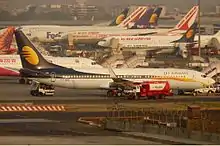
Most of the State's airfields are operated by the Airports Authority of India (AAI) while Reliance Airport Developers (RADPL), currently operate five non – metro airports at Latur, Nanded, Baramati, Osmanabad and Yavatmal on a 95-year lease.[18] The Maharashtra Airport Development Company (MADC) was set up in 2002 to take up development of airports in the state that are not under the AAI or the Maharashtra Industrial Development Corporation (MIDC). MADC is playing the lead role in the planning and implementation of the Multi-modal International Cargo Hub and Airport at Nagpur (MIHAN) project.[19]
Maharashtra has three international airports:
- Mumbai's Chhatrapati Shivaji Maharaj International Airport (among the busiest airports in India);
- Pune Airport with flights to Dubai, Frankfurt and Sharjah;
- Nagpur's Dr. Babasaheb Ambedkar International Airport.
- Nashik Airport serves domestic flights.
Airports at Akola, Amravati, Baramati, Chandrapur, Dhule, Gondia, Jalgaon, Karad, Kolhapur, Latur, Nashik Road Airport, Nanded, Osmanabad, Ratnagiri, Solapur and Yavatmal do not have any scheduled air services. There are also private airstrips at Aamby Valley City and Shirpur.[20]
A greenfield airport is being built by the MADC at Shirdi while IRB Infrastructure is constructing Sindhudurg Airport. A new passenger terminal at Ozar Airport near Nashik was inaugurated in March 2014.[21] Navi Mumbai International Airport, being built by CIDCO for ₹90 billion (US$1.3 billion) is in the land acquisition stage.[22] The New Pune International Airport is being planned near Pune[23] as well as greenfield airports at Boramani (near Solapur) and Gadchiroli.[19]
Water transport
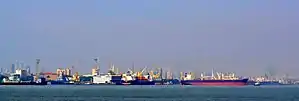
Historically, the ports on the Konkan coast have served as the gateway to the Deccan region. most of these have diminished importance but do serve as fishing ports.The two principal sea ports of maharashtra and also of india, Mumbai Port and Jawaharlal Nehru Port, which is also in the Mumbai region, are under the control and supervision of the government of India.[24] There are around 48 minor ports in Maharashtra.[25] Most of these handle passenger traffic and have a limited capacity. None of the major rivers in Maharashtra are navigable and so river transport does not exist in the state.
See also
References
- "MMRDA – Projects – Skywalk". MMRDA. Archived from the original on 14 March 2009. Retrieved 24 March 2009.
- S.Shanker (23 November 2008). "Mumbai pedestrians can walk safe in the sky". The Hindu Business Line. p. 1. Archived from the original on 10 February 2009. Retrieved 24 March 2009.
- Hemalata C. Dandekar (1986). Men to Bombay, Women at Home: Urban Influence on Sugao Village, Deccan Maharashtra, India, 1942–1982. Popular Prakashan. p. 44. ISBN 978-0-89148-036-5.
- Momongan VG. Reproduction in draught animals. Draught Animal Power for Production. ACIAR Proceedings. 1985 Jul 10;10:123-9.
- Richard M. Eaton (17 November 2005). A Social History of the Deccan, 1300–1761: Eight Indian Lives. Cambridge University Press. pp. 59–62. ISBN 978-0-521-25484-7.
- Mushirul Hasan, India partitioned: the other face of freedom, vol. 1, Lotus Collection, 1995, 120 p. (ISBN 8174360123), p. 103.
- "Table No 2". Morth.nic.in. 31 March 1996. Retrieved 16 July 2010.
- "Maharashtra – Physical Infrastructure, Roads" (PDF). India Brand Equity Foundation. November 2011. Retrieved 31 March 2012.
- "Statistics". Mahapwd.com. 31 March 2000. Retrieved 16 July 2010.
- "Kolkata Metro is now the 17th zone of Indian Railways". The Times of India.
- R.R. Bhandari (2005). Indian Railways: Glorious 150 years. Ministry of Information and Broadcasting, Government of India. pp. 44–52. ISBN 978-81-230-1254-4.
- "Geography: Railway zones". Indian Railways Fan Club. Retrieved 23 December 2008.
- "Maharashtra – Physical Infrastructure, Railways" (PDF). IBEF. November 2011. Retrieved 31 March 2012.
- http://www.tramz.com/tva/in.html
- "Airlines of the world: India". Flight Global. 27 April 1939. Retrieved 21 September 2011.
- "New Service in India". Flight Global. 2 February 1939. Retrieved 21 September 2011.
- "Airstrips in Maharashtra". Maharashtra Public Works Department. Retrieved 1 April 2012.
- "Reliance Airport gets five projects on lease". The Times of India. 6 August 2009. Retrieved 19 September 2011.
- "MIDC projects". Maharashtra Airport Development Company. Archived from the original on 26 February 2012. Retrieved 31 March 2012.
- "List of Aerodromes Licensed under Private Category" (PDF). Directorate General of Civil Aviation (India). Retrieved 23 December 2012.
- "Ozar terminal to be inaugurated on March 2". The Times of India. 25 February 2014. Retrieved 25 February 2014.
- "Navi Mumbai International Airport (NMIA)". CIDCO. Retrieved 31 March 2012.
- "Airport near Rajgurunagar, Pune". Maharashtra Airport Development Company. Retrieved 31 March 2012.
- "List of ports in Maharashtra". Regional Port Offices. Maharashtra Maritime Board. Archived from the original on 3 February 2014. Retrieved 1 February 2014.
- "Sea ports of Maharashtra". Geo cities organisation. Archived from the original on 22 February 2014. Retrieved 13 February 2014.
